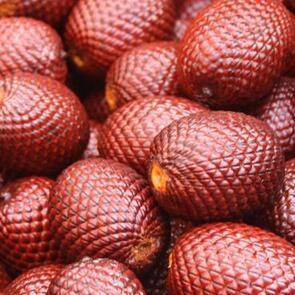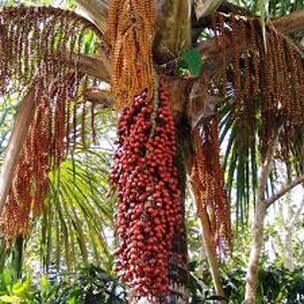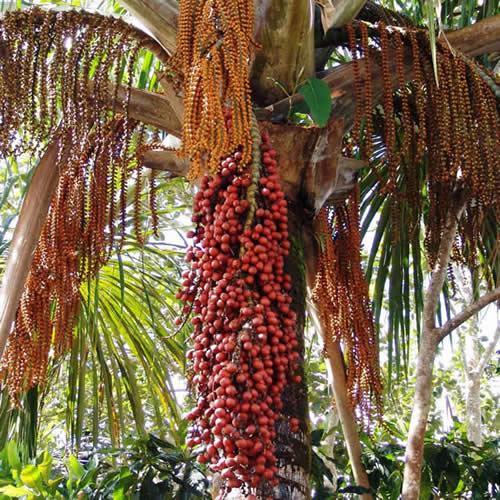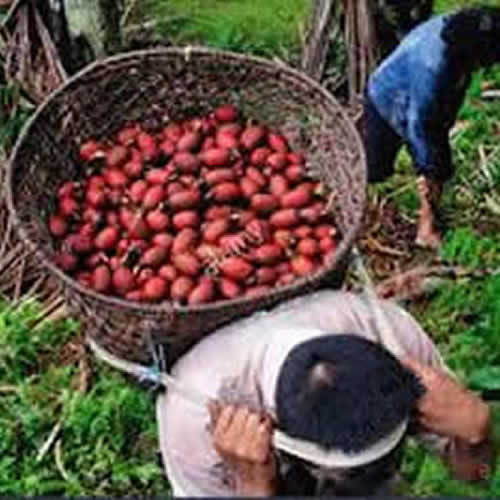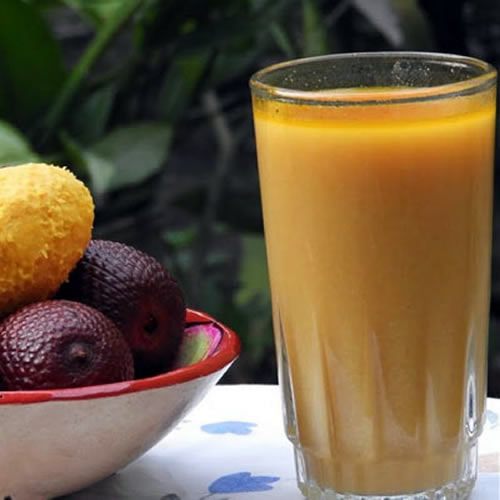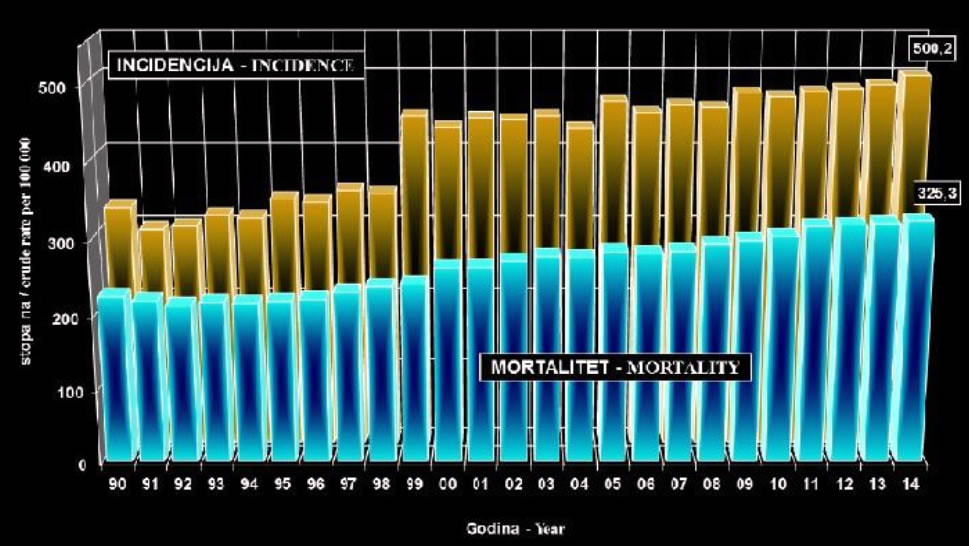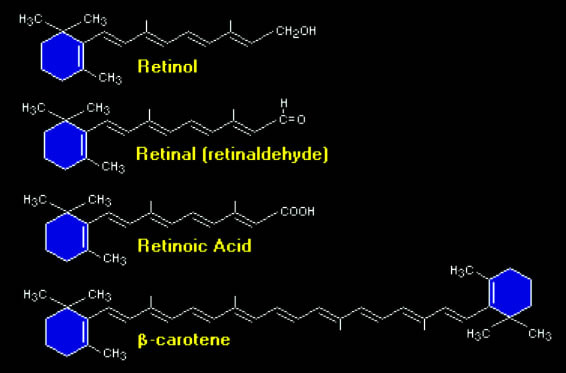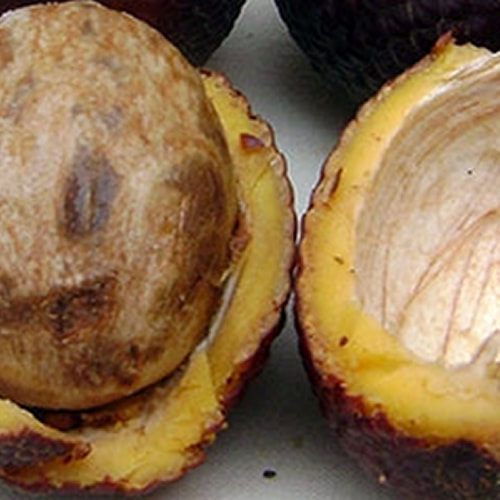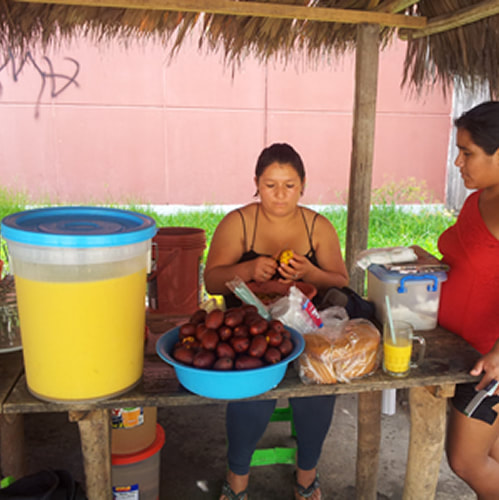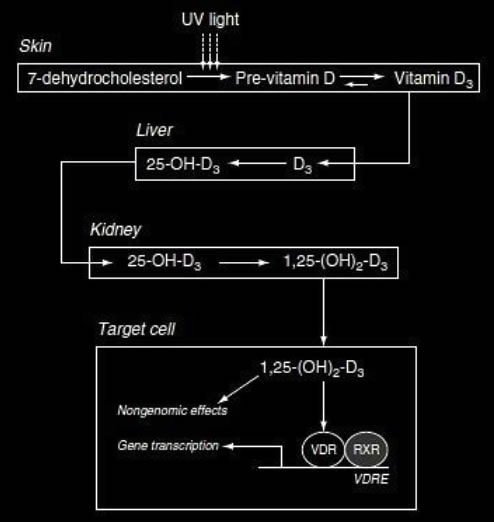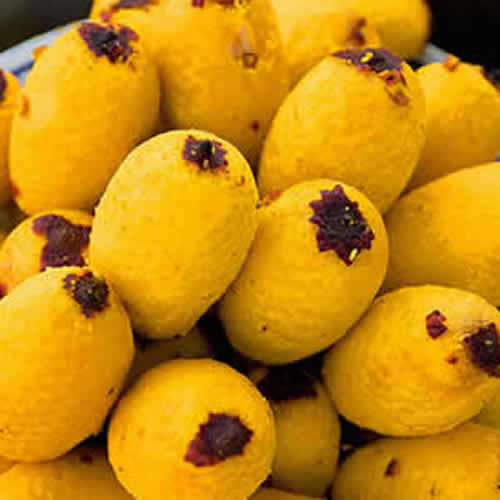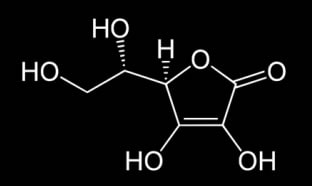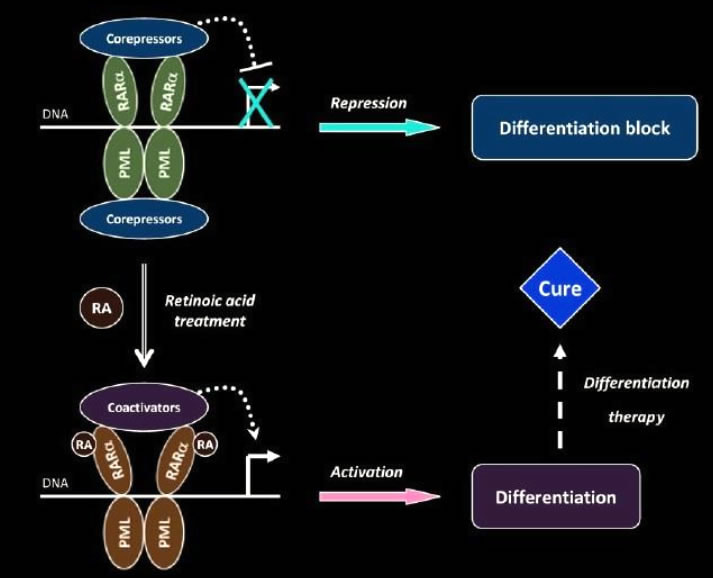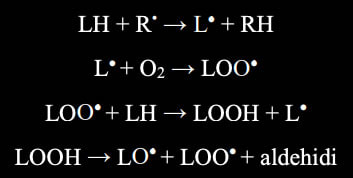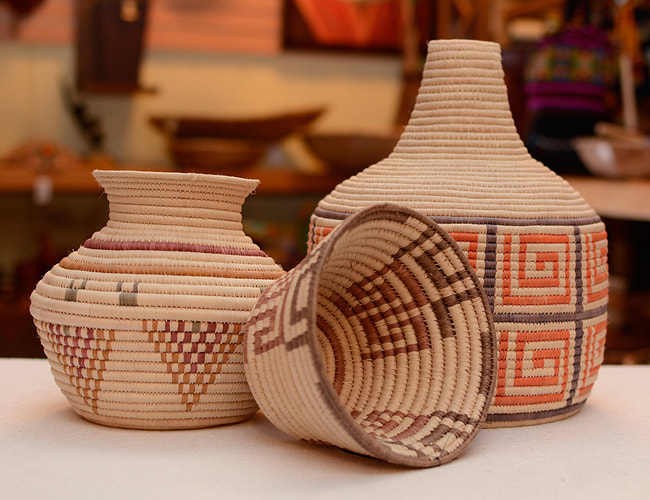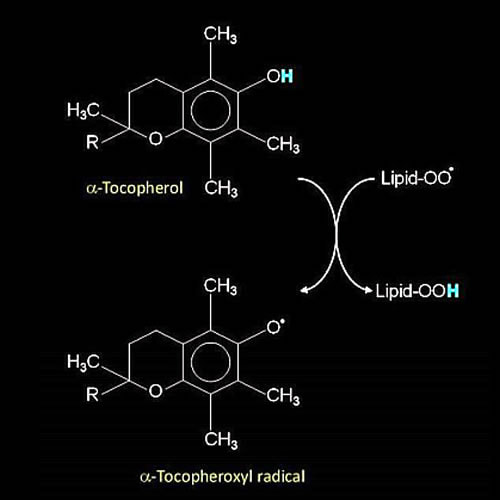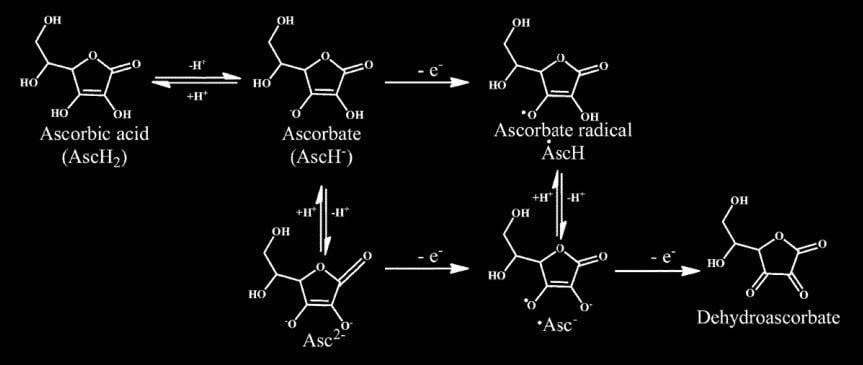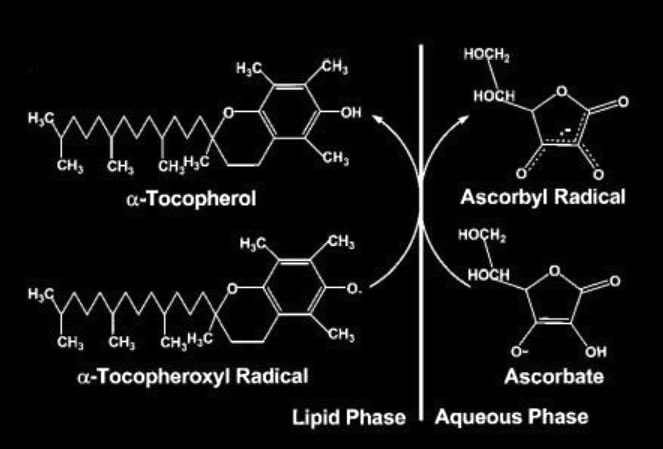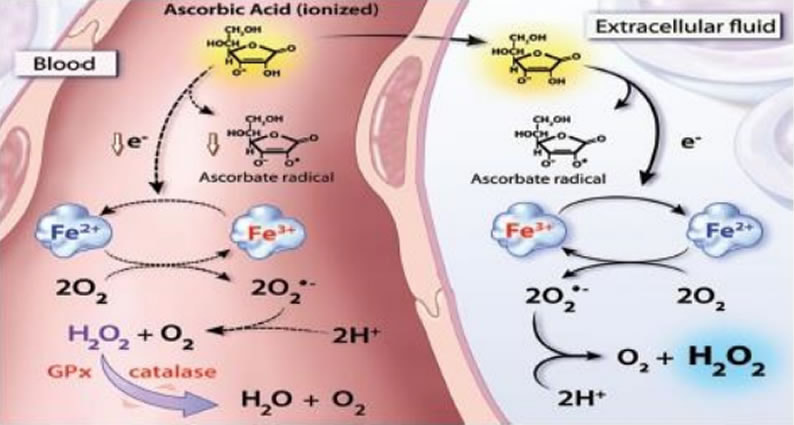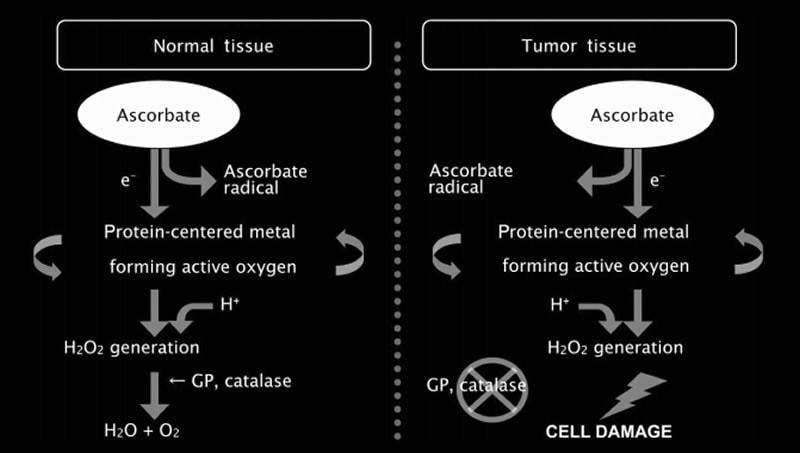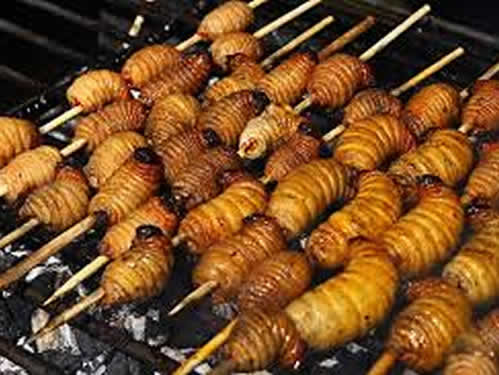Mild Phytoestrogens For Breast Enlargement and Unidentified Complaints in Postmenopausal and Premenopausal Periods
1. Introduction
Aguaje (Moriche palm) belonging to a palm is a fruit of Maritia flexuosa cultivated in riverside of Amazon in Peru and Brazil. (Fig. 1) The shape is oval and the surface is covered with scaly skin. The fruit weighing 40-50 g contains a large seed and the edible part contains yellow to orange carotenoids. The taste is like a steamed sweat potato. The fruit paste diluted with water is popular drink in the area and fruits are used for processed foods such as ice candy, cocking oil and dietary supplements. As constituents in Aguaje, fatty acids and those triglycerides1) and polysaccharides2, 3) have been reported. As health benefitting effects, cholesterol lowerring4) , anti-thrombogenic5) and anti-oxidative activities have been reported6, 7) . Moreover, Aguaje is said to enlarge breast and had been considered to contain phytoestrogens. However, the active ingredients had not been identified.
Fig. 1. Aguaje fruit (left) and whole plant
We studied chemical constituents in Aguaje for almost 2 years and found that the phytoestrogens are puterocarpans, named lespeflorins G8 (LF), G9 8) and 8-hydorxyhomopterocarpan (8-HHP). (Fig. 2.)
Fig. 2.Phytoestrogens in Aguaje
2. Estrogenic activities of Aguaje phytoestrogens
1)Computer binding simulation to estrogen receptors
Lespeflorin G8 (LF) possessing anti-melanogenic acitivty8) have not been reported to show estrogenic activity. Therefore, we evaluated affinities of LF and 8-HHP to estrogen receptor-alfa by computer simulation. Alfa-Receptors are dominant receptor expressing in genitarium, liver, kidneys, mammary gland and adipose tissue. Besides, Alfa-receptors are in ovary, bladder, intestine and bone tissues. Bone estrogen alfa-receptors contribute to maintenance of bone mass. As a result, LF was found to bind to 2 amino acid residues of alfa-receptor protein with 81.9 nM inhibition constant which was relatively higher ligand activity. (Fig. 3) This value is 11 times higher than that of soy bean equol (939 nM). The result suggests that LF can bind to -receptor with high affinity.
Fig. 3. Binding image of LF to estrogen -receptor Red:LF, pale blue:17-estradiol
Fig. 4. Binding image of 8-HHP to estrogen -receptor
While, 8-HHP possesses 1 amino acid residue and the inhibition constant was 1,990 nM. Thus, binding affinity of 8-HHP to -receptor is lower than LF (Fig. 4). Referring binding affinity to -receptor, inhibition constants of LF and 8-HHP were 2,460 and 3,397 nM. Hence binding affinities of both compounds were not found to be strong. In conclusion, major phytoestrogen in Aguaje was suggested to be LF which has higher affinity to -receptor.
【Method】
Ligand information of LF and 8-HHP was obtained as SDF data from Pubchem. Then, the data was changed to PDP data by Avogadro1.0.2 and the optimization of structure and energy minimization of 3D structure was performed by Arguslab 4.0.1. In terms of receptor information, 3D structure of human estrogen receptor- (PDB ID: 1G50) was obtained from Protein Data Bank and structure of 17-estradiol was eliminated from the crystal structure by AutoDock (v. 4.2). The PDB data of receptor was used. AutoDock (v. 4.2) was used for docking simulation. Briefly, Grid was developed to surround binding pockets for blind docking. Diching was started by command prompt and repeated docking trial for 100 times. Docking model which has lowest binding energy was adopted. Finally, binding image was illustrated by Chimera and PyMOL.
2)Estrogenic activity(Effect on estrogen-dependent cell proliferation)
MCF-7 cells (human breast adenocarcinoma cells (Fig. 5) proliferate depending on estrogen in medium and frequently used for evaluation of estrogenic activities of phytoestrogens and endocrine-disrupting chemicals.9, 10) We added Aguaje or soy constituents to MCF-7 cultured in estrogen flee medium (with fetal bovine serum treated with charcoal and dextran) for 4 days. Cell proliferation was evaluated by MTT assay. As a result, LF and 8-HHP exhibited 25% significant cell proliferation at 10 M (Fig. 6). Among soy compounds, daidzein (1 M), genistein (0.08 M) and (S)-equol (0.03 M) showed cell proliferation similar to LF and 8-HHP. Therefore, estrogenic activities of LF and 8-HHP were found to be 1/10 of daidzein, 1/125 of genistein and 1/330 of (S)-equol.
Fig. 5. MCF-7 cells
Fig. 6. Effects of Aguaje and Soy compounds on MCF-7 proliferation Mean±SE(n=6-12), **: p<0.01.
References 9)
Yoshikawa M., Uemura T., Shimoda H., Kishi A., Kawahara Y., Matsuda H. Medicinal Foodstuffs. XVIII.: Phytoestrogens from the aerial part of Petroselinum crispum MILL. (Parsley) and structures of 6"-acetylapiin and a new monoterpene glycoside, petroside. Chem. Pharm. Bull., 48, 1039-1044 (2000). 10) Matsuda H., Shimoda H., Morikawa T., Yoshikawa M. Phytoestrogens from the roots of Polygonum cuspidatum (Polygonaceae): Structure-requirement of hydroxyanthraquinones for estrogenic activity. Bioorg. Med. Chem. Lett., 11, 1839-1842 (2001).
Yoshikawa M., Uemura T., Shimoda H., Kishi A., Kawahara Y., Matsuda H. Medicinal Foodstuffs. XVIII.: Phytoestrogens from the aerial part of Petroselinum crispum MILL. (Parsley) and structures of 6"-acetylapiin and a new monoterpene glycoside, petroside. Chem. Pharm. Bull., 48, 1039-1044 (2000). 10) Matsuda H., Shimoda H., Morikawa T., Yoshikawa M. Phytoestrogens from the roots of Polygonum cuspidatum (Polygonaceae): Structure-requirement of hydroxyanthraquinones for estrogenic activity. Bioorg. Med. Chem. Lett., 11, 1839-1842 (2001).
3)E-CALUX (Estrogen-Chemical Activated Luciferase gene eXpression) assay
E-CALUX assay is internationally used method for detection of endocrine-disrupting chemicals and phytoestrogens. We examined action properties of LF and 8-HHP by luciferase assay using human follicular cancer cells transfected luciferase gene (BG1 Luc4E2). As a result, we found that LF (lespeflorin G8) is a full agonist and 8-HHP (8-hydroxyhomopterocarpan) is a partial agonist to estrogen receptors (Fig. 7). EC50 values were LF: 1.3 g/mL (4.4 M) and 8-HHP: 3.2 g/mL (9.6 M). Thus contribution of LF to estrogenic activity of Aguaje extract is higher than 8-HHP. The result suggested that LF is more important for estrogenic activity of Aguaje extract.
Fig. 7. Binding properties of Aguaje constituents to estrogen receptors Mean±SD, n=4,17-estradiol is a dominant internal estrogen.
Fig. 8 shows comparison of estrogenic activities of various phytoestrogens and Aguaje constituents. Concentration of phytoestrogens showing similar activity to that of maximum estradiol are daidzein: 1,000 nM and genistein: 150 nM. On the other hand, LF is 5,000 nM. Therefore, estrogenic activity of LF in this assay is 1/5 of daidzein and 1/33 of genistein.
Fig. 8. Comparison of estrogenic activities of various phytoestrogens and Aguaje constituents
3. Anti-estrogen-like activity
Anti-estrogenic-like activity which antagonize to estrogen can be evaluated briefly by culturing previously described MCF-7 in medium containing estrogens. We added Aguaje and soy constituents to this assay condition and cultured MCF-7 for 3 days. Then MTT assay was performed. As a result, LF and 8-HHP (1 and 0.3 M) suppressed cell proliferation as well as tamoxifen (breast cancer medicine). (Fig. 9) The effect was not found in soy constituents.
Fig. 9. Anti-estrogenic-like activity of Aguaje and soy constituents Mean±SE, n=10-12, **: p<0.01, *: p<0.05.
4. Effect on Uterus
1)Effect on endometrial carcinoma cell proliferation
Ishikawa cells (endometrial carcinoma cell,Fig. 10) proliferate estrogen-dependently. We cultured Ishikawa cells under estrogen free condition and evaluated the effect of Aguaje constituents. As a result, LF and 8-HHP did not affect to the cell proliferation unlikely to tamoxifen (Fig. 11). Thus, LH and 8-HHP were found to enhance endometrial carcinoma.
10. Ishikawa cells
Fig. 11. Effect of Aguaje constituents and tamoxifen on Ishikwa cell proliferation. Mean±SE, n=10-12
2)Effect on mouse uterus weight
We gave orally estrogen fraction of Aguaje extract (LF contents: 0.25%) to mice for 2 weeks. As a result, no significant increase in uterus weight was not observed (Fig. 12). Thus, Aguaje extract was found to give not effect on uterus.
Fig. 12. Effect of Aguaje estrogen fraction on mouse uterus wight Mean±SE, n=6-7
Oral administration of soy genistein increases uterus weight in immature mice11) and matured mice (B6D2F1) 12, 13) Increase in endometrial tissue in normal range is caused by normal effect of estrogen and not concerned seriously. However some biologists announce that this kind of effects in soy isoflavon are not preferable, because it may relates to cancer initiation. 14, 15) As Aguaje extract cause significant increase in uterus weight, it has lower risk of side effect in on uterus.
References)
11) Breinholt V., Hossaini A., Svendsen G.W., Brouwer C., Nielsen E. Estrogenic activity of flavonoids in mice. The importance of estrogen receptor distribution, metabolism and bioavailability. Food Chem. Toxicol. 38, 555-564 (2000).
12) Song T.T., Hendrich S., Murphy P.A. Estrogenic activity of glycitein, a soy isoflavone. J. Agric. Food Chem. 47, 1607-1610 (1999). 13) Cline J.M., Franke A.A., Register T.C., Golden D.L., Adams M.R. Effects of dietary isoflavone aglycones on the reproductive tract of male and female mice. Toxicol. Pathol. 32, 91-99 (2004). 14) Kaludjerovic J., Chen J., Ward W.E. Early life exposure to genistein and daidzein disrupts structural development of reproductive organs in female mice. J. Toxicol. Environ. Health A. 75, 649-660 (2012). 15) Kanno J., Kato H., Iwata T., Inoue T. Phytoestrogen-low diet for endocrine disruptor studies. J. Agric. Food Chem, 50, 3883-3885 (2002)..
11) Breinholt V., Hossaini A., Svendsen G.W., Brouwer C., Nielsen E. Estrogenic activity of flavonoids in mice. The importance of estrogen receptor distribution, metabolism and bioavailability. Food Chem. Toxicol. 38, 555-564 (2000).
12) Song T.T., Hendrich S., Murphy P.A. Estrogenic activity of glycitein, a soy isoflavone. J. Agric. Food Chem. 47, 1607-1610 (1999). 13) Cline J.M., Franke A.A., Register T.C., Golden D.L., Adams M.R. Effects of dietary isoflavone aglycones on the reproductive tract of male and female mice. Toxicol. Pathol. 32, 91-99 (2004). 14) Kaludjerovic J., Chen J., Ward W.E. Early life exposure to genistein and daidzein disrupts structural development of reproductive organs in female mice. J. Toxicol. Environ. Health A. 75, 649-660 (2012). 15) Kanno J., Kato H., Iwata T., Inoue T. Phytoestrogen-low diet for endocrine disruptor studies. J. Agric. Food Chem, 50, 3883-3885 (2002)..
5.Clinical trial, Effect of Aguaje extract on QOL
We evaluated the effect of Aguaje extract on female condition by open trial. After 28-day ingesting period of Aguaje extract (100 mg/day), questionnaire was performed to evaluate QOL condition.
○Method
1.Subjects:Japanese female in our company 2. Intervention:Ingested a capsule containing 100 mg of Aguaje extract once before breakfast 3.Test period :28 days 4.Outcome: SF-36 (Ver. 2) questionnaire (1) Vitality (2) physical functioning (3) bodily pain (4) general health perceptions (5) physical role functioning (6) emotional role functioning (7) social role functioning (8) mental health (9) Physical component summary: PCS (10) Mental component summary: MCS (11) Role/Social component summary: RCS
1.Subjects:Japanese female in our company 2. Intervention:Ingested a capsule containing 100 mg of Aguaje extract once before breakfast 3.Test period :28 days 4.Outcome: SF-36 (Ver. 2) questionnaire (1) Vitality (2) physical functioning (3) bodily pain (4) general health perceptions (5) physical role functioning (6) emotional role functioning (7) social role functioning (8) mental health (9) Physical component summary: PCS (10) Mental component summary: MCS (11) Role/Social component summary: RCS
○SF-36 (Ver. 2)
1. general, would you say your health is: Excellent 1 Very good 2 Good 3 Fair 4 Poor 5
2. Compared to one year ago, Much better now than one year ago 1 Somewhat better now than one year ago 2 About the same 3 Somewhat worse now than one year ago 4 Much worse now than one year ago 5
3. The following items are about activities you might do during a typical day. Does your health now limit you in these activities? If so, how much? Yes, Limited a Lot (1) Yes, Limited a Little (2) No, Not limited at All (3) a. Vigorous activities, such as running, lifting heavy objects, participating in strenuous sports b. Moderate activities, such as moving a table, pushing a vacuum cleaner, bowling, or playing golf c. Lifting or carrying groceries d. Climbing several flights of stairs e. Climbing one flight of stairs f. Bending, kneeling, or stooping
4. During the past 4 weeks, have you had any of the following problems with your work or other regular daily activities as a result of your physical health? Yes (1) No (2) a. Cut down the amount of time you spent on work or other activities b. Accomplished less than you would like c. Were limited in the kind of work or other activities d. Had difficulty performing the work or other activities
5. During the past 4 weeks, have you had any of the following problems with your work or other regular daily activities as a result of any emotional problems? a. Cut down the amount of time you spent on work or other activities b. Accomplished less than you would like c. Didn't do work or other activities as carefully as usual
6. During the past 4 weeks, to what extent has your physical health or emotional problems interfered with your normal social activities with family, friends, neighbors, or groups? Not at all 1 Slightly 2 Moderately 3 Quite a bit 4 Extremely 5
7. How much bodily pain have you had during the past 4 weeks? None 1 Very mild 2 Mild 3 Moderate 4 Severe 5 Very severe 6
8. During the past 4 weeks, how much did pain interfere with your normal work (including both work outside the home and housework)? Not at all 1 A little bit 2 Moderately 3 Quite a bit 4 Extremely 5
9. How much of the time during the past 4 weeks . All of the Time 1 Most of the Time 2 A Good Bit of the Time 3 Some of the Time 4 A Little of the Time 5 None of the Time 6
a. Did you feel full of pep?
b. Have you been a very nervous person?
c. Have you felt so down in the dumps that nothing could cheer you up?
d. Have you felt calm and peaceful?
e. Did you have a lot of energy?
f. Have you felt downhearted and blue?
g. Did you feel worn out?
h. Have you been a happy person?
i. Did you feel tired?
10. During the past 4 weeks, how much of the time has your physical health or emotional problems interfered with your social activities (like visiting with friends, relatives, etc.)? All of the time 1 Most of the time 2 Some of the time 3 A little of the time 4 None of the time 5
11. How TRUE or FALSE is each of the following statements for you. (Circle One Number on Each Line)
Definitely True 1
Mostly True 2
Don't Know 3
Mostly False 4
Definitely False 5
a. I seem to get sick a little easier than other people
b. I am as healthy as anybody I know
c. I expect my health to get worse
d. My health is excellent
1. general, would you say your health is: Excellent 1 Very good 2 Good 3 Fair 4 Poor 5
2. Compared to one year ago, Much better now than one year ago 1 Somewhat better now than one year ago 2 About the same 3 Somewhat worse now than one year ago 4 Much worse now than one year ago 5
3. The following items are about activities you might do during a typical day. Does your health now limit you in these activities? If so, how much? Yes, Limited a Lot (1) Yes, Limited a Little (2) No, Not limited at All (3) a. Vigorous activities, such as running, lifting heavy objects, participating in strenuous sports b. Moderate activities, such as moving a table, pushing a vacuum cleaner, bowling, or playing golf c. Lifting or carrying groceries d. Climbing several flights of stairs e. Climbing one flight of stairs f. Bending, kneeling, or stooping
4. During the past 4 weeks, have you had any of the following problems with your work or other regular daily activities as a result of your physical health? Yes (1) No (2) a. Cut down the amount of time you spent on work or other activities b. Accomplished less than you would like c. Were limited in the kind of work or other activities d. Had difficulty performing the work or other activities
5. During the past 4 weeks, have you had any of the following problems with your work or other regular daily activities as a result of any emotional problems? a. Cut down the amount of time you spent on work or other activities b. Accomplished less than you would like c. Didn't do work or other activities as carefully as usual
6. During the past 4 weeks, to what extent has your physical health or emotional problems interfered with your normal social activities with family, friends, neighbors, or groups? Not at all 1 Slightly 2 Moderately 3 Quite a bit 4 Extremely 5
7. How much bodily pain have you had during the past 4 weeks? None 1 Very mild 2 Mild 3 Moderate 4 Severe 5 Very severe 6
8. During the past 4 weeks, how much did pain interfere with your normal work (including both work outside the home and housework)? Not at all 1 A little bit 2 Moderately 3 Quite a bit 4 Extremely 5
9. How much of the time during the past 4 weeks . All of the Time 1 Most of the Time 2 A Good Bit of the Time 3 Some of the Time 4 A Little of the Time 5 None of the Time 6
a. Did you feel full of pep?
b. Have you been a very nervous person?
c. Have you felt so down in the dumps that nothing could cheer you up?
d. Have you felt calm and peaceful?
e. Did you have a lot of energy?
f. Have you felt downhearted and blue?
g. Did you feel worn out?
h. Have you been a happy person?
i. Did you feel tired?
10. During the past 4 weeks, how much of the time has your physical health or emotional problems interfered with your social activities (like visiting with friends, relatives, etc.)? All of the time 1 Most of the time 2 Some of the time 3 A little of the time 4 None of the time 5
11. How TRUE or FALSE is each of the following statements for you. (Circle One Number on Each Line)
Definitely True 1
Mostly True 2
Don't Know 3
Mostly False 4
Definitely False 5
a. I seem to get sick a little easier than other people
b. I am as healthy as anybody I know
c. I expect my health to get worse
d. My health is excellent
Fig. 13. Effect of Aguaje extract of female QOL status Median with quartiles, n=17
As a result bodily pain, vitality, social functioning and mental component summary were significantly improved by Aguaje extract ingestion (Fig. 13). Thus, Aguaje extract enhances vitality and social functioning through ameliorating bodily pain.
6.Clinical trial, Randomized placebo-controlled clinical trialof Aguaje extract on anxieties during menstruation period
We conducted 8-week clinical trial of Aguaje extract on general malaise in healthy Japanese subjects.
【Methods】
(1) Subjects and registration criteria Japanese females having general malaise during pre- and during menstruation periods,
(2) Exclusion criteria Omitted
(3) Selection criteria i. Persons who were judged having no problem for participation by a doctor ii. Among person with criteria і having relatively higher MDQ scores.
(4) Test sample Aguaje group: A capsule containing 50 mg of Aguaje extract Placebo group: Placebo capsule
(5) Testing period 8 weeks
(6) Dosage Aguaje group: taking 2 Aguaje capsules once a day with water before breakfast Placebo group: taking 2 placebo capsules once a day with water before breakfast
(7) Primary outcomes i. MDQ (Menstrual Distress Questionnaire) Japanese version a. Contents: Evaluate QOL using MDQ before, during and post menopausal periods. b. Evaluating term: total score, lower scale, each term
(2) Exclusion criteria Omitted
(3) Selection criteria i. Persons who were judged having no problem for participation by a doctor ii. Among person with criteria і having relatively higher MDQ scores.
(4) Test sample Aguaje group: A capsule containing 50 mg of Aguaje extract Placebo group: Placebo capsule
(5) Testing period 8 weeks
(6) Dosage Aguaje group: taking 2 Aguaje capsules once a day with water before breakfast Placebo group: taking 2 placebo capsules once a day with water before breakfast
(7) Primary outcomes i. MDQ (Menstrual Distress Questionnaire) Japanese version a. Contents: Evaluate QOL using MDQ before, during and post menopausal periods. b. Evaluating term: total score, lower scale, each term
【Lower terms】
Pain、Water Reten、Auto React、Neg Affect、Impair Conc、Behave Change、 Arousal、Control
【Items】
「Stiffed muscle」「Headache」「Lower abdominal pain」「Lumber pain」 「Fatigue」「Body pain」「Increase in bodyweight」「Skin roughness, skin trouble」「Breast pain」「bloatedness in breast and abdomen」「Dizzy」「Cold sweat」「Nausea, vomiting」「hot flash」「Feeling loneliness」「Feeling anxiety」 「Mood swing」「Tearing」「Frustrated」「Tension」「Melancholy」「Feel upset」 「Insomnia」「Forgetful」「Difficulty in consideration」「Lucking consideration」 「Lucking concentration ability」「Getting distraction」「Making slight mistakes」 「unable to move as expected」「Reduction of performances in schools and office」「Taking a nap, difficulty in waking up」「Shut-in」「Hesitating to meet others 」「 Decrease in working performances 」「 Beloved feeling 」「 Feel organized 」「 Exhilarated feeling 」「 Feeling happy 」「 Energetic active 」 「Choking」「Chest pain」「Ringing ears」「Numbness」「pricking pain」「Narrowing eye sight」
Evaluation: 0 to 4 scale. 0.「No symptoms」、1.「Slight symptom or slightly feel」、2.「moderate feeling (symptoms)」、3.「Strong feeling (symptoms)」、4.「Severe feeling (symptoms)」
(8) Secondary symptoms i. MOS Short-Form 36-Item Health. Survey (SF-36) a. Parameters 【Summary score】 Physical component summary (PCS), mental component summary (MCS), Role/Social component summary (RCS) 【Lower scale】 Physical performance, daily physical roles, body pain, healthy feeling, vitality, socially living functions, daily mental roles, emotional health
(9) Measurements Breast size
【Results】
In primary outcomes (MDQ), 4-week Aguaje consumption significantly improved “Feeling exhilarated” in pre-menopausal period (Fig. 14). By 8-week consumption, summary score, water retention, concentration ability and control were significantly improve during menopausal period. As lower MDQ means good conditions, Aguaje consumption seems to improve these parameters. Referring a table bellow Fig. 14, Aguaje extract was found to improve cold sweat and tearing in menstruation period by 8-week consumption. Improving trends were also observed in breast pain, bloatedness in breast and abdomen, feeling anxiety, mood swing, tearing, getting distraction,making slight mistakes and unable to move expected. In SF-36 parameters, RCS and daily mental role were significantly improved in Aguaje group. In lower scales,
Fig. 14. Parameters showing significant differences to placebo group
Then we plotted BMI and breast size (top - under) to analyze effect of Aguaje extract on breast size. Trend of increasing in breast size was observed in subjects with less than 20 kg/m2 of BMI (Fig. 15).
Fig. 15. Relationship of breast size and BMI
Moreover, as a result of plotting age and breast size, positive trend was observed in Aguaje group (Fig. 16). Similar results were obtained by plotting same parameters of before and after consumption of capsules (Fig. 17). Before the consumption, Aguaje group showed negative trend. Instead the group showed horizontal trend after 8-week Aguaje consumption. However, placebo group maintained negative trends in both before and after capsule consumption.
Fig. 16. Relationship between age and breast height.
Fig. 17. Relationship between age and height of breast top from ground.
Thus, 8-week Aguaje extract consumption was found to enlarge breast in subjects with relatively skinny style. In addition, preventive effect on breast sagging toward aging.
7. Stability of Aguaje Extract
(1) Heat stability
We heated Aguaje extract at 120ºC for 1 hr. to examine heat stability. As a result, LF content was slightly decreased (8%). LF seems to be relatively stable at the temperature on processing foods (Fig. 18).
Fig. 18. Heat stability of Aguaje extract
8. Nutrition facts
*1) 100 –(water + insoluble fraction in ether)
*2) 100 – (water + protein + fat + ash)
*3) 100 – (Water + protein + fat + fiber + ash)
*4) Energy conversion: protein 4, fat 9, sugar 4, fiber 2
*5) Calculated from sodium
Test trustee: Food Analysis Technology Centre SUNATEC
Date of analysis:May 25, 2018(Extract),May 25, 2018(P), June 8, 2018 (L)
Test No.:180515525-001-01(Extract),180515525-002-01(P), 180524533-001-01 (L)
*2) 100 – (water + protein + fat + ash)
*3) 100 – (Water + protein + fat + fiber + ash)
*4) Energy conversion: protein 4, fat 9, sugar 4, fiber 2
*5) Calculated from sodium
Test trustee: Food Analysis Technology Centre SUNATEC
Date of analysis:May 25, 2018(Extract),May 25, 2018(P), June 8, 2018 (L)
Test No.:180515525-001-01(Extract),180515525-002-01(P), 180524533-001-01 (L)
9. Safety
(1) Residual Agricultural Chemical
We examined residual agricultural chemicals for 535 chemicals in Aguaje extract. No residual agricultural chemicals were detected, Test trustee:Masis,Date:March 27, 2018
Test No.:118279
Sample name: Aguaje oil (extract)
Test No.:118279
Sample name: Aguaje oil (extract)
(2) Acute toxicity(LD50)
Acute Toxicity of Aguaje Extract was conducted according to the Guidelines for Single-Dose Toxicity Tests for Pharmaceutical Products where Aguaje Extract 2,000 mg/kg was orally given to mice (ICR, 7-week old). And the mice were observed for 14 days. No abnormalities and fatal event observed at 2,000 mg/kg. No abnormalities of organs observed under macroscopic examination upon autopsy. Thus, LD50 of Aguaje Extract is deduced to be >2,000 mg/kg.
(3) Mutagenicity
Ames test was conducted to evaluate the mutagenicity of Aguaje Extract using Salmonella typhimurium TA98, TA100, TA1535, TA1537 and E.coli WP2 at concentration 19.5 – 5,000 g/plate, no mutagenicity was observed.
10. Recommended dosage
We recommend 100 mg/day of Aguaje extract, 330 mg/day of Aguaje extract-P and -L based on the result of clinical trial.
11. Application
12. Packaging
Aguaje extract 1 kg, 5 kg, 16 kg Interior packaging:Tin can Exterior packaging:Cardboard
Aguaje extract-P -powder 1 kg, 5kg Interior packing: Aluminum bag Exterior packaging: Cardboard
Aguaje extract--L 1 kg Interior packing: Polyethylene bottle Exterior packing: Cardboard
5 kg, 20 kg Interior packing: Cubic polyethylene container Exterior packing: Cardboard
Aguaje extract-P -powder 1 kg, 5kg Interior packing: Aluminum bag Exterior packaging: Cardboard
Aguaje extract--L 1 kg Interior packing: Polyethylene bottle Exterior packing: Cardboard
5 kg, 20 kg Interior packing: Cubic polyethylene container Exterior packing: Cardboard
13. Storage
Avoid high temperature and humid. Store in cool, dry dark place.
14. Example
Aguaje extract Moriche palm oil / Mixed tocopherol
Aguaje extract-P Maltodextrin, moriche palm oil / Acacia gum, mixed tocopherol
Aguaje extract-L Purified water, moriche palm oil / glycerin ester of fatty acid, glycerin, antioxidant (mixed tocopherol)
Aguaje powder Moriche palm powder
PRODUCT STANDARD
PRODUCT NAME : AGUAJE EXTRACT(Oil, for foods)
This product is an oil extracted from Moriche palm(Mauritia flexuosa)fruits. It guarantees minimum of 20 g/g of lespeflorin G8.
Appearance Grayish orange brown to orange oil with slightly characteristic odor.
Acid Value Max. 10.0
Lespeflorin G8 Min. 20 μg/g (HPLC)
Purity Test
(1) Heavy Metals (as Pb) Max. 20 ppm (Sodium Sulfide Colorimetric Method)
(2) Arsenic (as As2O3) Max. 1 ppm (Standard Methods of Analysis in Food Safety Regulation, The Third Method, Apparatus B) Standard Plate Counts Max. 1×102 cfu/g (Analysis for Hygienic Chemists)
Moulds and Yeasts Negative (Analysis for Hygienic Chemists)
Coliforms Negative (Analysis for Hygienic Chemists)
Composition Ingredient Content Moriche Palm Oil 99.9% Mixed Tocopherol 0.1% Total 100.0%
Expiry date 2 years from date of manufacturing.
Storage Store in a dry, ventilated location. Keep away from high tempe rature and sun light.
Acid Value Max. 10.0
Lespeflorin G8 Min. 20 μg/g (HPLC)
Purity Test
(1) Heavy Metals (as Pb) Max. 20 ppm (Sodium Sulfide Colorimetric Method)
(2) Arsenic (as As2O3) Max. 1 ppm (Standard Methods of Analysis in Food Safety Regulation, The Third Method, Apparatus B) Standard Plate Counts Max. 1×102 cfu/g (Analysis for Hygienic Chemists)
Moulds and Yeasts Negative (Analysis for Hygienic Chemists)
Coliforms Negative (Analysis for Hygienic Chemists)
Composition Ingredient Content Moriche Palm Oil 99.9% Mixed Tocopherol 0.1% Total 100.0%
Expiry date 2 years from date of manufacturing.
Storage Store in a dry, ventilated location. Keep away from high tempe rature and sun light.
PRODUCT NAME : AGUAJE EXTRACT-P(Powder, for foods)
This product is powder of oil extracted from Moriche palm (Mauritia flexuosa) fruits. It guarantees minimum of 5 μg/g of lespeflorin G8.
Appearance Pale yellowish white to pale orange white powder with slightly characteristic odor.
Lespeflorin G8 Min. 5 μg/g (HPLC) Loss on Drying Max. 10.0 % (Analysis for Hygienic Chemists, 1 g, 105ºC, 2 hr)
Purity Test
(1) Heavy Metals (as Pb) Max. 20 ppm (Sodium Sulfide Colorimetric Method)
(2) Arsenic (as As2O3) Max. 1 ppm (Standard Methods of Analysis in Food Safety Regulation, The Third Method, Apparatus B) Standard Plate Counts Max. 1×103 cfu/g (Analysis for Hygienic Chemists)
Moulds and Yeasts Max. 1×102 cfu/g (Analysis for Hygienic Chemists)
Coliforms Negative (Analysis for Hygienic Chemists)
Composition Ingredient Content Maltodextrin 50.00% Moriche Palm Oil 29.97% Acacia Gum 20.00% Mixed Tocopherol 0.03% Total 100.00%
Expiry date 2 years from date of manufacturing.
Storage Store in a dry, ventilated location. Keep away from high tempe rature and sun light.
Lespeflorin G8 Min. 5 μg/g (HPLC) Loss on Drying Max. 10.0 % (Analysis for Hygienic Chemists, 1 g, 105ºC, 2 hr)
Purity Test
(1) Heavy Metals (as Pb) Max. 20 ppm (Sodium Sulfide Colorimetric Method)
(2) Arsenic (as As2O3) Max. 1 ppm (Standard Methods of Analysis in Food Safety Regulation, The Third Method, Apparatus B) Standard Plate Counts Max. 1×103 cfu/g (Analysis for Hygienic Chemists)
Moulds and Yeasts Max. 1×102 cfu/g (Analysis for Hygienic Chemists)
Coliforms Negative (Analysis for Hygienic Chemists)
Composition Ingredient Content Maltodextrin 50.00% Moriche Palm Oil 29.97% Acacia Gum 20.00% Mixed Tocopherol 0.03% Total 100.00%
Expiry date 2 years from date of manufacturing.
Storage Store in a dry, ventilated location. Keep away from high tempe rature and sun light.
PRODUCT NAME : AGUAJE EXTRACT-L (Water-soluble emulsion, for foods)
This product is water soluble emulsion of oil extracted from Moriche palm (Mauritia flexuosa) fruits. It guarantees a minimum of 5 μg/g of lespeflorin G8.
Appearance Pale yellowish white to orange white liquid with slightly characteristic odor.
Lespeflorin G8 Min. 5 μg/g (HPLC)
Purity Test
(1) Heavy Metals (as Pb) Max. 20 ppm (Sodium Sulfide Colorimetric Method)
(2) Arsenic (as As2O3) Max. 1 ppm (Standard Methods of Analysis in Food Safety Regulation, The Third Method, Apparatus B) Standard Plate Counts Max. 1×103 cfu/g (Analysis for Hygienic Chemists) Moulds and Yeasts Max. 1×102 cfu/g (Analysis for Hygienic Chemists)
Coliforms Negative (Analysis for Hygienic Chemists)
Composition Ingredient Content Purified Water 35.00% Moriche Palm Oil 29.97% Glycerin Ester of Fatty Acid 20.00% Glycerin 15.00% Mixed Tocopherol 0.03% Total 100.00%
Expiry date 2 years from date of manufacturing.
Storage Store in a dry, ventilated location. Keep away from high tempe rature and sun light.
Lespeflorin G8 Min. 5 μg/g (HPLC)
Purity Test
(1) Heavy Metals (as Pb) Max. 20 ppm (Sodium Sulfide Colorimetric Method)
(2) Arsenic (as As2O3) Max. 1 ppm (Standard Methods of Analysis in Food Safety Regulation, The Third Method, Apparatus B) Standard Plate Counts Max. 1×103 cfu/g (Analysis for Hygienic Chemists) Moulds and Yeasts Max. 1×102 cfu/g (Analysis for Hygienic Chemists)
Coliforms Negative (Analysis for Hygienic Chemists)
Composition Ingredient Content Purified Water 35.00% Moriche Palm Oil 29.97% Glycerin Ester of Fatty Acid 20.00% Glycerin 15.00% Mixed Tocopherol 0.03% Total 100.00%
Expiry date 2 years from date of manufacturing.
Storage Store in a dry, ventilated location. Keep away from high tempe rature and sun light.
PRODUCT NAME : AGUAJE POWDER(Powder、for foods, Build-to-order manufacturing)
This product is dried powder of Moriche palm (Mauritia flexuosa) fruits.
Appearance Pale brown to brown powder with slightly characteristic odor.
Loss on Drying Max. 10.0 % (Analysis for Hygienic Chemists, 1 g, 105ºC, 2 hr)
Purity Test
(1) Heavy Metals (as Pb) Max. 20 ppm (Sodium Sulfide Colorimetric Method)
(2) Arsenic (as As2O3) Max. 1 ppm (Standard Methods of Analysis in Food Safety Regulation, The Third Method, Apparatus B) Standard Plate Counts Max. 3×103 cfu/g (Analysis for Hygienic Chemists)
Moulds and Yeasts Max. 1×103 cfu/g (Analysis for Hygienic Chemists)
Coliforms Negative (Analysis for Hygienic Chemists)
Composition Ingredient Content Moriche Palm Fruits 100.0%
Expiry date 2 years from date of manufacturing.
Storage Store in a dry, ventilated location. Keep away from high tempe rature and sun light.
Loss on Drying Max. 10.0 % (Analysis for Hygienic Chemists, 1 g, 105ºC, 2 hr)
Purity Test
(1) Heavy Metals (as Pb) Max. 20 ppm (Sodium Sulfide Colorimetric Method)
(2) Arsenic (as As2O3) Max. 1 ppm (Standard Methods of Analysis in Food Safety Regulation, The Third Method, Apparatus B) Standard Plate Counts Max. 3×103 cfu/g (Analysis for Hygienic Chemists)
Moulds and Yeasts Max. 1×103 cfu/g (Analysis for Hygienic Chemists)
Coliforms Negative (Analysis for Hygienic Chemists)
Composition Ingredient Content Moriche Palm Fruits 100.0%
Expiry date 2 years from date of manufacturing.
Storage Store in a dry, ventilated location. Keep away from high tempe rature and sun light.

